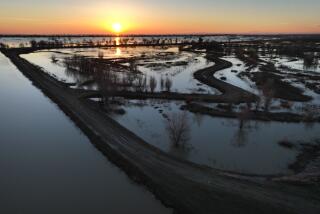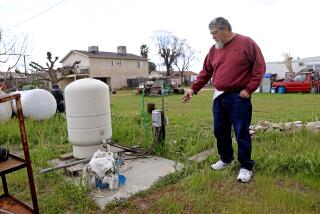Driest Year Since 1977 : Gold Country Forced to Dig for More Water
- Share via
PLYMOUTH, Calif. — Every day since mid-July, Margaret Anderson has been saving the rinse water from the dishes to sprinkle her vegetable garden here. She said it is the first time since the drought of 1977 that the city’s Water District has asked her to limit garden watering to an hour every other day.
It is a struggle, she said. Her front lawn has already bit the dust. “It is sad,” said the 83-year-old retired teacher. “I even had to ask my (visiting) daughter not to wash her hair.”
Plymouth, a small town 30 miles east of Sacramento, is one of several communities in Amador and Tuolumne counties that are feeling the effects of what state officials call the driest year since the drought of 1976-77. While at least two Sierra Nevada communities reported dried-up water sources, wells and canals are beginning to run low all over California’s Gold Country, and residents have been asked by local authorities to conserve water.
River Low on Water
Plymouth Vice Mayor Gene Beck, calling the situation “a crisis,” said the town is being forced to get by on 70% of the water it normally uses. For years, Plymouth has been relying on an open ditch dating from the 19th-Century Gold Rush for its normal water consumption of 250,000 gallons a day. But since the south and middle forks of the Cosumnes River, which feed the ditch, ran dry several weeks ago, the city has gone to a number of wells and has requested $170,000 in emergency funds from the state Water Resources Department to sink a new one, Beck said.
“If there were a major fire, you could only stand there and watch your house burn, because there’s not enough water to put it out,” said Mannie Cranford, a 36-year-old Plymouth teacher.
Wells Going Dry
Less than two weeks ago, wells ran dry at Leisure Pines in Tuolumne County, a new subdivision with a population of 150 people 30 miles east of Sonora, said Marvin Pahl, president of the Leisure Pines Mutual Water Co.
“It will be critical until the snows come,” said Pahl, whose district had to invest $20,000 to drill a 1,000-foot well. Wells are Leisure Pines’ only source of water, he said.
At least three other small communities in Amador and Tuolumne counties have been said to be short or out of water, but officials there were not available to confirm those reports. “For some mountain communities there is not a whole lot that can be done but drop more wells,” said Bill Helms of the Water Resources Department, calling 1987 a “critical year.”
“Those mountain communities are usually where the first signs of trouble begin because they often have inadequate groundwater systems,” he said. “But part of the problem is also related to increasing developments in those areas, and that increases the demand for water.”
Extra Last Year
Helms said he could not estimate how widespread the water shortages are in the Sierra Nevada, because reports are slow to reach his department. But he added that the previous winter produced enough extra runoff to avert a major water crisis this year.
Since October, precipitation in Yosemite National Park has been only 51% of the normal level. In the Sacramento area, the figure is 69%. “We’re short of water, but we have enough to see us through the rest of the year,” Helms said. “All our eyes are on next year.”
But Beck said he hoped Plymouth’s request for emergency funds will be approved and drilling will begin within a month. Until then, he said, the community’s 700 residents will have to do with 180,000 gallons a day.
More to Read
Sign up for Essential California
The most important California stories and recommendations in your inbox every morning.
You may occasionally receive promotional content from the Los Angeles Times.










